Celebrating Mothers And Mentors This Mother’s Day
Mother’s Day is for celebrating mothers, but it’s also an opportunity to honor anyone who has filled that nurturing role in our lives. Whether it’s a grandma, aunt, stepmother, mentor,…
A Hearts and Arrows diamond is a modern round brilliant, cut to show crisp 3D optical precision, also called optical symmetry. When a diamond is cut with scientifically proven “ideal proportions” and is additionally fine-tuned to show a crisp pattern of “hearts and arrows,” it belongs to an extremely rare subset of round diamonds known as Super Ideal.
Before going on: Check out the PriceScope Diamond Buying Guide
These pages may reference products from companies that help to support PriceScope.
Intermediate Hearts and Arrows
Advanced Hearts and Arrows
Wondering which of the many diamond colors is best for you? Our elite list of vetted vendors like Whiteflash and James Allen are experts at listening and helping you determine which combo of the 4Cs is perfect for you - and nicely in budget. Contact Us and get help today.
When assessing diamond cut, a Hearts and Arrows diamond, also called “H&A,” is one fashioned so precisely that its facet reflections overlap when seen in the structured light environment of a hearts and arrows viewer.
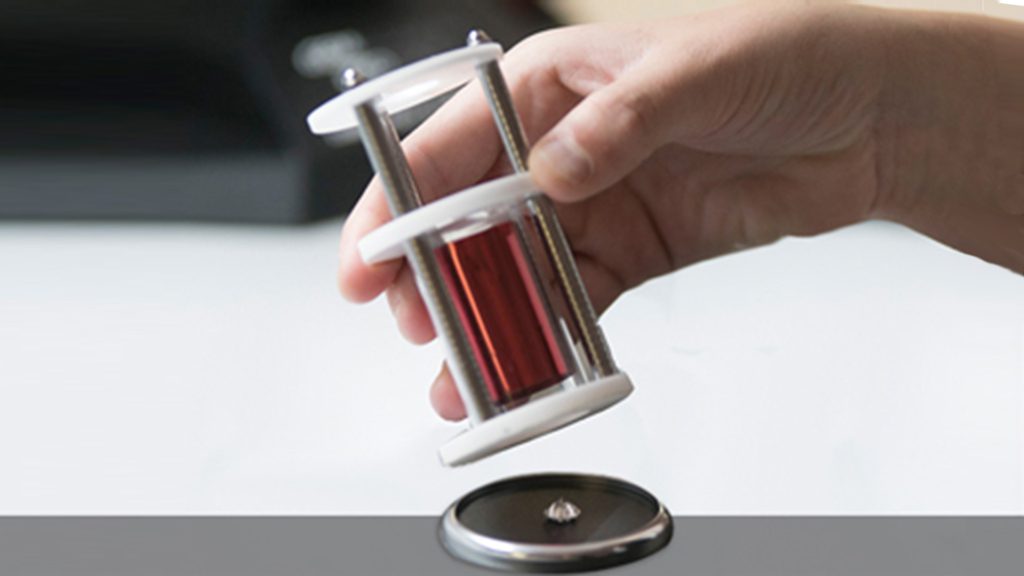
The kaleidoscopic pattern seen face-down in the pavilion resembles “hearts,” and the pattern seen face-up in the crown resembles “arrows.” Hearts and arrows optical precision is usually associated with Ideal or Excellent cuts of superior quality.
Diamonds of Superior Quality: Several of PriceScope’s vetted vendors carry exclusive Hearts and Arrows diamonds. Check out these special collections: Whiteflash A CUT ABOVE® and James Allen True Hearts™ diamond brands.
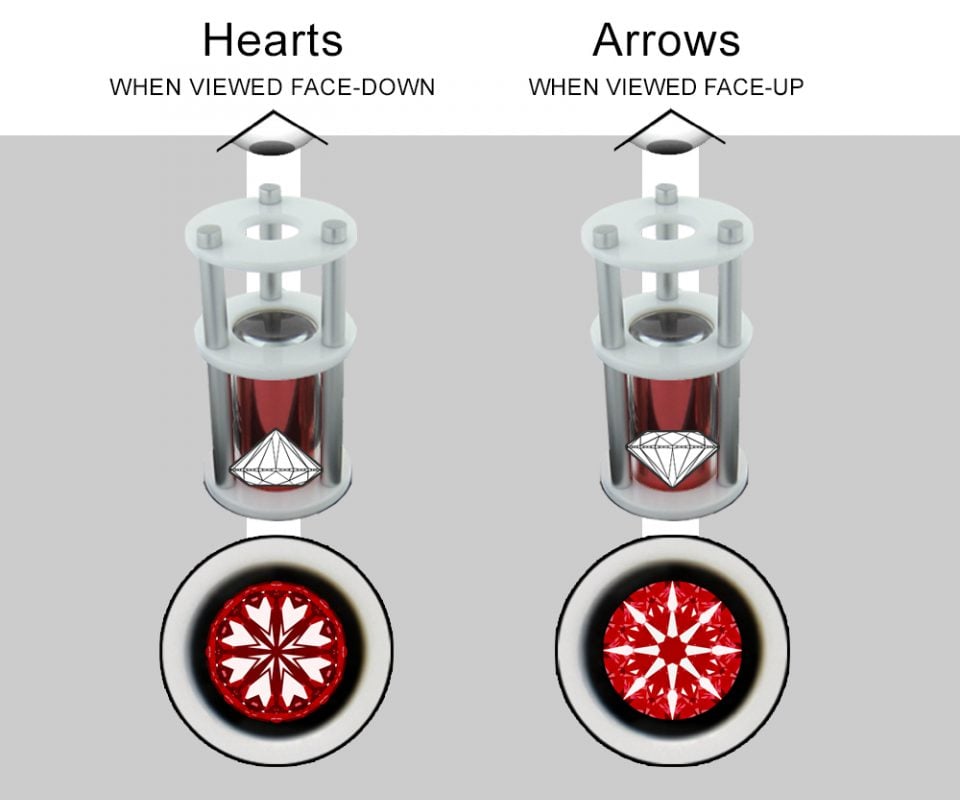
PriceScope’s 1-5 star ratings are categorical comparisons with the most thorough, consumer-focused online diamond and jewelry vendors, in categories, we believe reflect our experienced consumer community’s values. Check out PriceScope Jeweler Reviews.
Light entering the viewer from above remains white. Light coming from the sides is colored by filament paper (typically red, blue or purple). This creates a structured lighting environment where the diamond’s primary facet reflections stand out as white against a darker background for analysis.
Are Hearts and Arrows diamonds all Super Ideal?
Not necessarily. Only 3-5% of all diamonds graded ‘Excellent’ or ‘Ideal’ fall into the Super Ideal subset (PriceScope estimate), making them extremely rare. To meet PriceScope’s definition of Super Ideal, a diamond must be cut within a small range of scientifically proven “ideal” proportions. Beyond those basic proportions, the internal reflections must be further fine-tuned to display crisp 3D optical precision (aka Hearts & Arrows) in a specialized viewer. Top Super Ideal diamonds are not casually or accidentally made.
Do you want H&A combined with Ideal Light Performance? The Whiteflash A CUT ABOVE® brands boast diamonds with H&A photos and additional proof of performance – supported by the AGS Platinum Light Performance Report.
Are all Hearts and Arrows diamonds the same?
No. Different definitions and standards exist. Some are stricter than others. Many diamonds produced in modern times mimic hearts and arrows patterns, simply from good tooling. These diamonds are sometimes nicknamed “Happy Accident” H&A diamonds. They may show patterns in viewers, but do not have the distinct crispness and precision of diamonds purposely refined to show the highest levels of 3D Optical Precision.
The examples in rows B, C and D lack the optical precision of the examples in row A and cannot be considered hearts and arrows diamonds by any meaningful standard, although some jewelers might sell them with that label. Not every example in row A passes the strictest expert standards, but they’re representative of what many professionals classify as hearts and arrows diamonds.
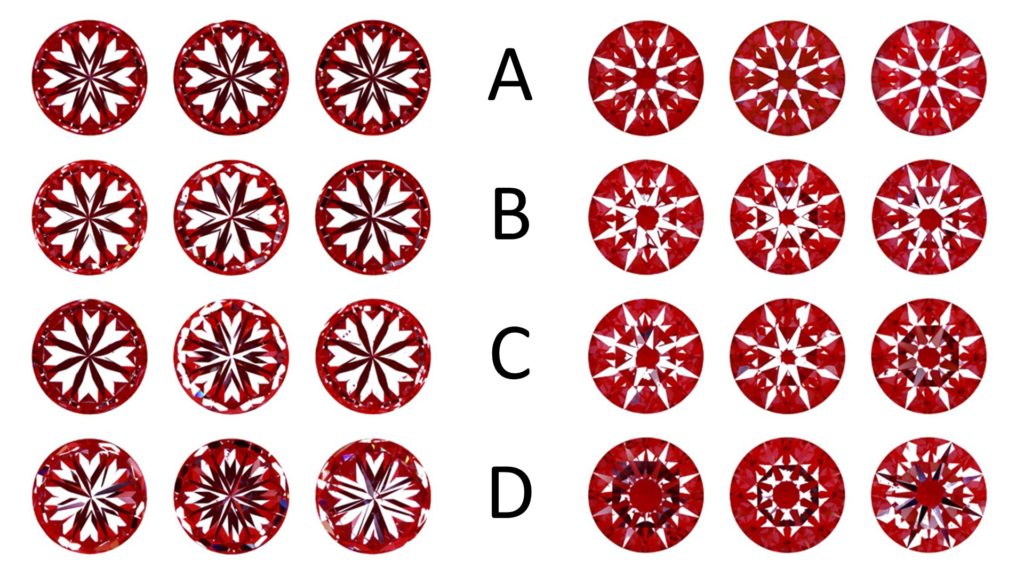
Anyone selling a diamond as “hearts and arrows” should be willing to provide actual images like those above, taken in a hearts and arrows viewer, to demonstrate the diamond was fine-tuned to have a high degree of optical precision. Those images may be red, purple or blue, depending on the color of the filament paper inside the viewer.
If you’re looking to buy loose diamonds online, use our special tools to reveal the best cut quality diamonds! Start your diamond search and choose from over a million loose diamonds for sale. Use our filters to find either natural or lab diamonds, as well as fancy color diamonds.
Intermediate Hearts and Arrows
Yes, primarily due to weight loss incurred in refinement. Achieving strong hearts and arrows optical precision is an exacting process. All facets must be aligned in both angle and orientation in a three-dimensional way.
The three examples below are hypothetically polished from the same starting rough crystal (the dark blue outline). They would all receive the “Excellent” cut grade. The specimen which meets PriceScope’s definition of Super Ideal cost more to produce because it required more hours, better tools and, most notably, more weight loss from the original diamond crystal.
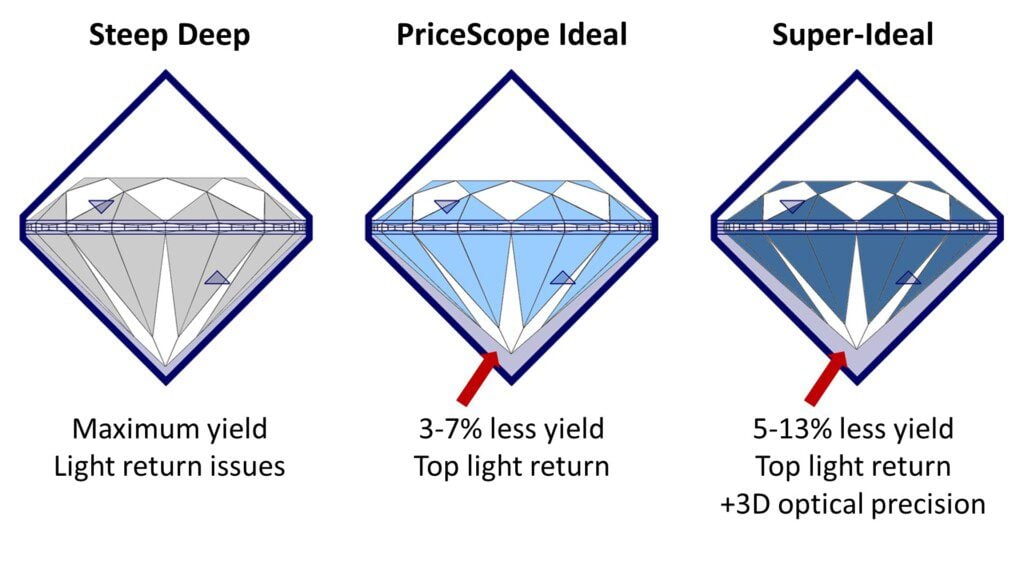
The payoff is the potential to optimize light performance through cut-consistency: Top brightness can be achieved by cutting to angles which promote optimum light return. Optimizing the size of the diamond’s internal reflections, or compound mirrors, promotes wider bands of dispersion, which our eyes see as fire.
The top-tier laboratories which apply grading standards for the hearts and arrows diamond are IGI and GCAL.
When submitting a diamond, the producer can request for anything to be inscribed on that diamond. For example, the producer could ask for “D-Flawless” to be inscribed on a J-SI1 diamond and that inscription would then become listed in the comments section. Therefore, when you see the notation that a diamond has “Hearts and Arrows” or “H&A” inscribed on its girdle issued by a laboratory that does not grade hearts and arrows, be cautious. Such an inscription does not mean a hearts and arrows standard was passed. It only means the producer requested for those characters to be inscribed when the diamond was submitted to the lab.
Because of a diamond’s refractive index, the pavilion and crown need to be cut at angles that complement each other and return light to the viewers’ eyes. No matter how crisp the hearts and arrows optical precision maybe, if the primary angles don’t compliment each other the diamond begins to leak light, which affects light return. Hearts and arrows diamonds need separate assessment for light return. A hearts and arrows viewer doesn’t give any indication of light performance.
Just because a diamond is cut to have AGS ideal performance does not mean that it will exhibit a crisp hearts and arrows pattern. Here is an example of a diamond that has AGS Ideal Light Performance, but would be completely unacceptable by any meaningful hearts and arrows standard:
Be advised that the symmetry grade, found on every diamond grading report, is not an assessment of optical precision. It is completely blind to how internal facet reflections may or may not overlap to form H&A patterns.
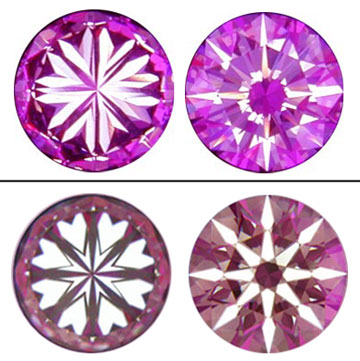
The difference in facet relationships is obvious, but on paper the symmetry grade is the same. This is how H&A patterning – resulting from optical precision – is not the same thing as lab graded symmetry.
A laboratory symmetry grade largely involves 2D surface judgments about uniform facet shape, clean meet points and overall geometry. The formation of hearts and arrows involves polishing on the X,Y, and Z-axes, which is not assessed as any part of laboratory symmetry grading.
GIA has concluded that there is negligible visible difference between VG and EX in symmetry and polish. They did find naked eyed experts who could sometimes detect lower symmetry in diamonds receiving Good or lower.
Since GIA and AGS do not currently grade hearts and arrows, the assessment of hearts and arrows quality in a GIA or AGS graded diamond requires separate analysis of that diamond’s 3D optical precision.
If you can’t examine the diamond in a hearts and arrows viewer yourself, then hearts and arrows photos made with a camera looking into the viewer are the best way to judge the degree of precision and accuracy to which the optical precision was executed.
Looking for actual hearts and arrows photos? James Allen, one of the world’s most successful online sellers, offers a line of Hearts and Arrows diamonds called True Hearts™ , supported with actual H&A photos, videos and performance images made in the Ideal Scope.
PriceScope vendors specializing in hearts and arrows diamond reliably provide actual hearts and arrows photos for diamonds they sell.
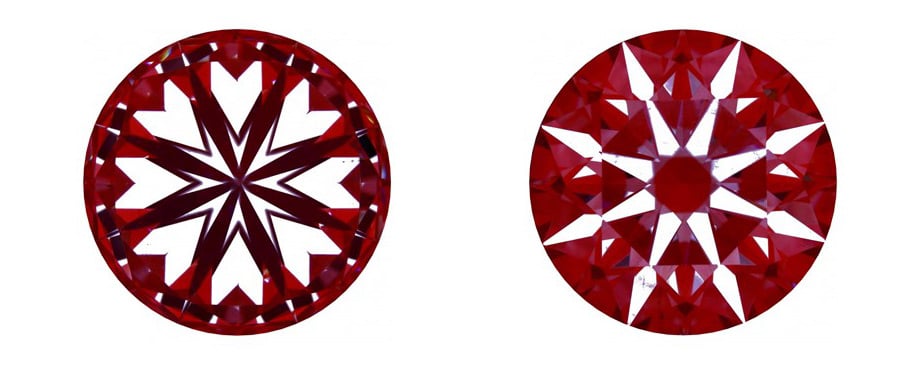
Some diamond industry software applications such as DiamCalc and the AGS light performance software are capable of generating photorealistic diamond images and videos. These computer generated renderings include performance scope (i.e. Ideal-Scope, ASET) simulations and optical precision scope (i.e. Hearts and Arrows) simulations.
PriceScope Pointer: Before using computer generated images (CGI) for analysis it’s critical to know whether the images were generated by manual input or from a mechanical 3D scan of the diamond.
The easiest way to produce computer-generated images (CGI) is to manually enter data from a grading report into the software. This is not useful and is misleading. When only broad average numbers are entered the software draws perfect 3D optical precision (which doesn’t exist in nature) and will produce images based on a theoretically perfect, unrealistic diamond wireframe.
The perfect optical patterns circled below are misrepresentations. It’s impossible to know how close or far away from the actual diamond’s hearts and arrows patterns these CGI may be. The data on laboratory reports is also averaged and rounded, adding a further margin of error.
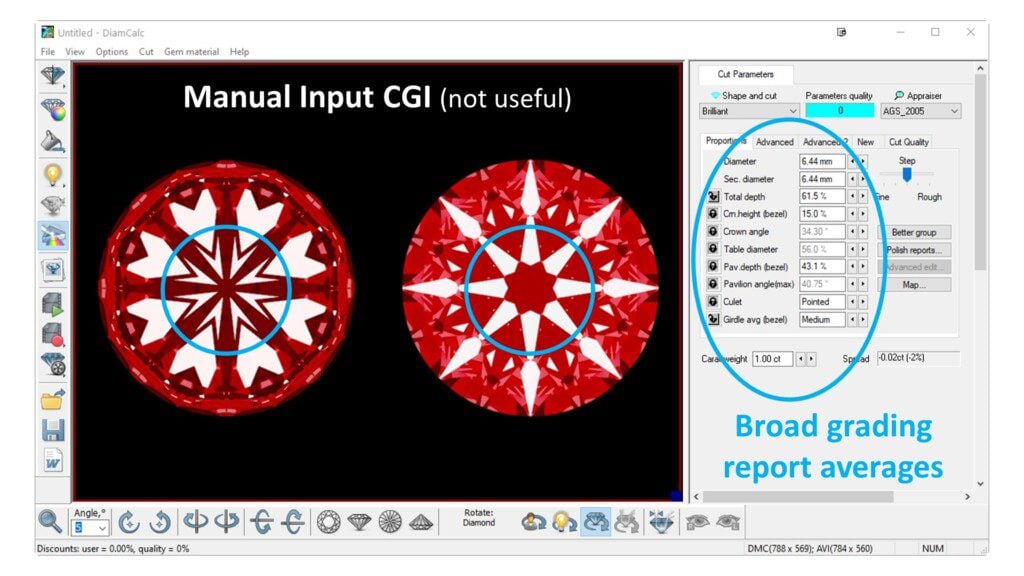
Images rendered from a 3D Scan (an actual mechanical scan of the diamond)
The only representative CGI are those made from a mechanical 3D scan of the actual diamond, executed with a non-contact diamond scanner such as Sarine or OGI. The hearts and arrows images generated by the software may be very close to actual hearts and arrows photos, depending on whether the scan was well-executed or not. They are still not as decisive as actual photos or in-person viewing for nuanced analysis.
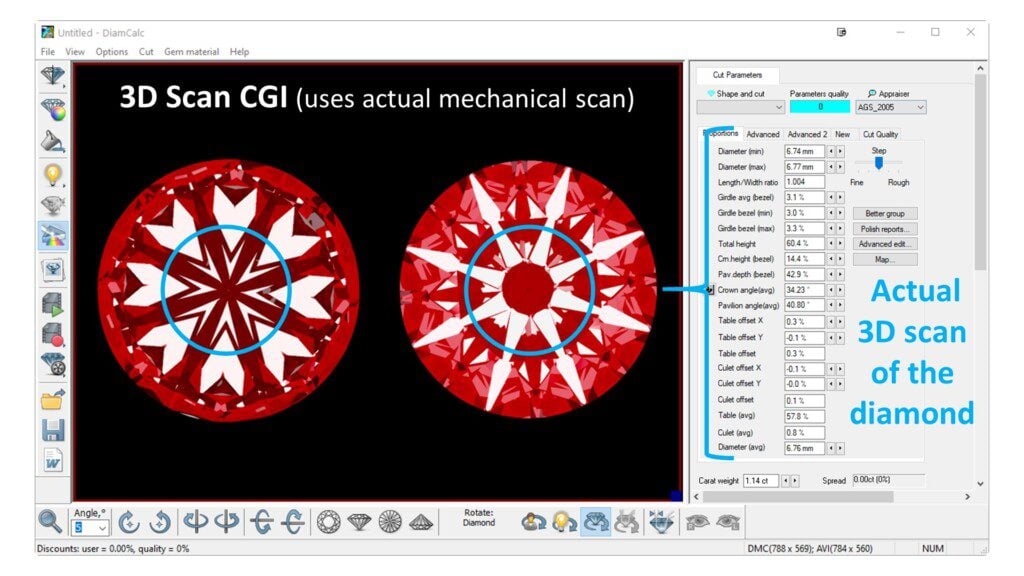
Because computer-generated images have the appearance of actual photos, it is important to verify with the seller if the imagery they are providing is actual photography of the diamond, or CGI. If the images are CGI, verify that the seller secured a mechanical 3D scan of the actual diamond.
PriceScope Pointer: Whether intentional or by accident, some diamond sellers provide Hearts and Arrows, Ideal-Scope and ASET simulations from manual input CGI. Those images do not represent the subject diamond and give a false positive impression. Be sure a mechanical 3D scan was used. You might also ask the seller to send you the 3D scan. Common file formats are .SRN .STL .DMC .ASC and DXF.
AGS Platinum Reports may have diamond specific renderings of ASET maps. When these are printed on “dual light map” or “triple light map” certificates, as seen below, an ASET image is rendered for the bottom of the diamond. The only purpose of that rendering is to simulate the hearts pattern in order to communicate 3D optical precision. Because these images are made from an actual 3D scan they can be very representative. They are not as decisive as actual photos or in-person viewing.
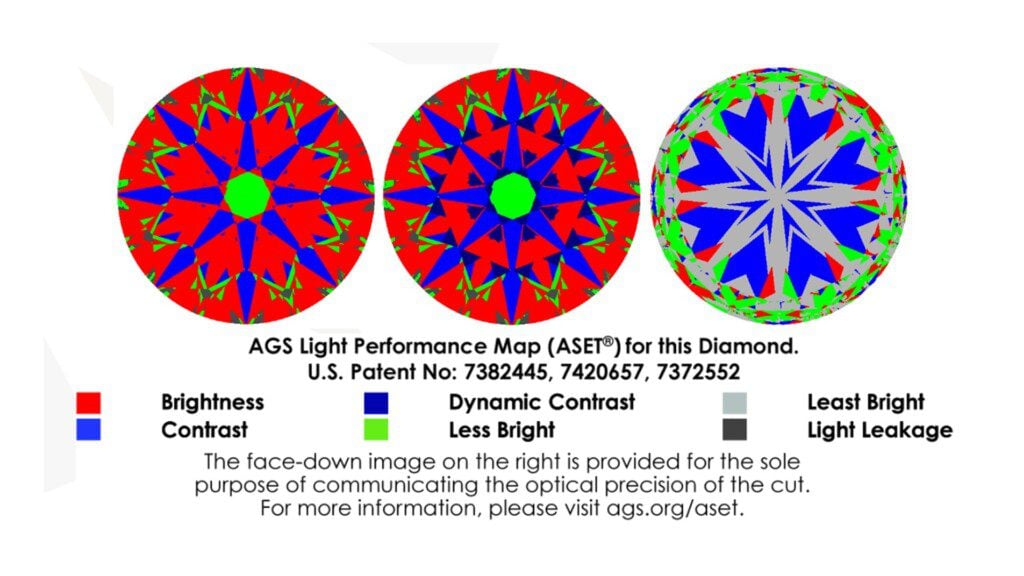
Advanced Hearts and Arrows Diamond
In the 1980s, Japanese diamond cutters were first to produce round brilliant diamonds cut so precisely that their facet reflections overlapped in 3D space, creating consistently-shaped patterns when seen through reflecting viewers.
Those polishers used “secret recipes” to create the pattern of hearts – a combination of reflections circled in red below – when looking down on the pavilion and arrows – reflections of the eight pavilion-main facets seen through table and bezels – in the crown, when viewed in the table-up position.
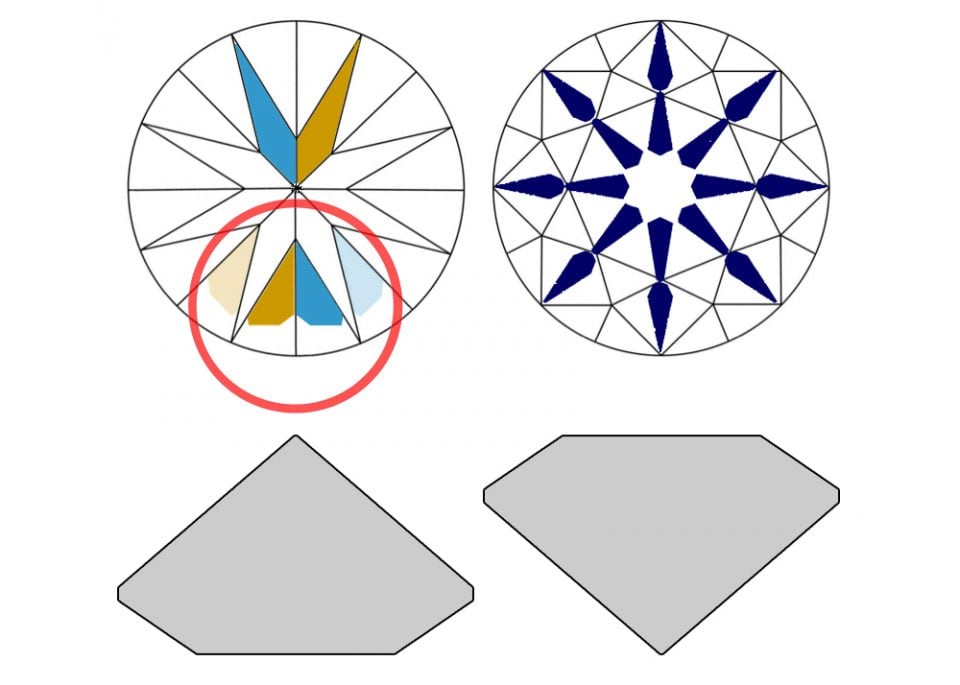
The precision and crispness of the patterns relies on precise angles in combination with specific facet length, width and azimuth. The techniques of the first producers spread to other cutting houses and hearts and arrows diamonds began appearing on several continents by the mid-1990s.
The eight uniform patterns seen in the top and bottom of hearts and arrows diamonds have a historical association with good fortune and spiritualism. The number eight is considered lucky in Asian culture. The arrow pattern has been compared to the Octagram of the I Ching, the Rinbo of Buddhist law and the eight-spoked wheel of Dharma, associated with spiritual perfection in the Buddhist faith.
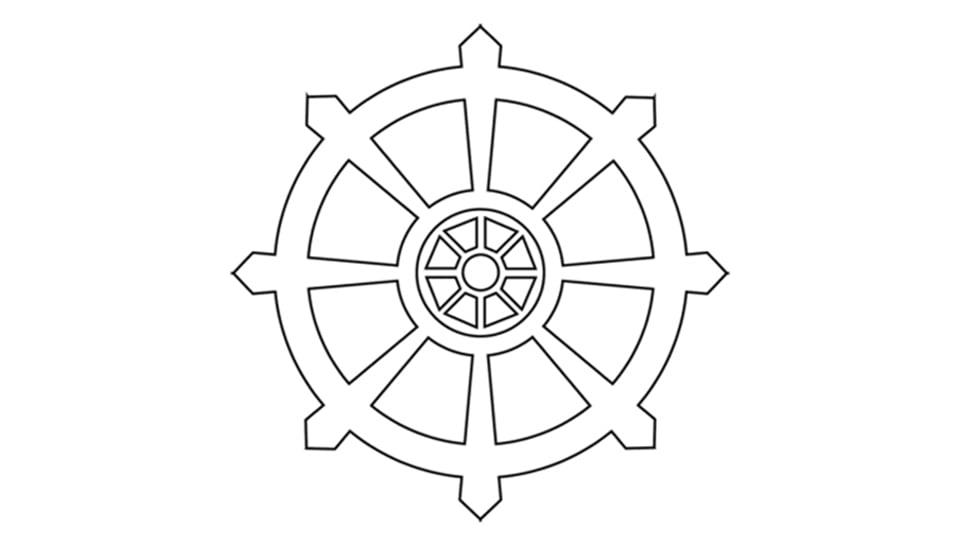
Regardless of spiritual belief, the achievement of the perfect hearts and arrows pattern, painstakingly cut into the world’s hardest substance, can be appreciated by any admirer. In its most fundamental form, it symbolizes the diamond cutter’s quest for perfection and the ultimate beauty of a diamond.
Our thanks to Whiteflash for providing the graphics and images below.
The rough diamond is prepared and sawed. Depending on the grain of the rough, this can happen in different ways. The flat, sawed surface will ultimately become the diamond’s table. The stone is then “bruted” or girdled (made round).

Next, the stone is “blocked:” first in four, then in eight. Four facets are polished on the top, forming the first crown main facets, next to the flat table facet.

Four main facets are also polished on the bottom, forming the first pavilion main facets. These ideally come to an exact point. The stone is now blocked in four.

The remaining facets are then polished on the top, for a total of eight main crown facets adjacent to the table, as well as the bottom, for a total of eight main pavilion facets. With these primary 17 facets in place (1 table facet, 8 crown facets and 8 pavilion facets) the diamond is now blocked in eight.

With the main facets in place, the upper and lower halves and stars are polished on the stone.

Here is a view of how the hearts and arrows are formed during the cutting process, seen through a hearts and arrows diamond viewer.


Just as the main pavilion facets are responsible for the formation of the hearts, they are also key in forming the arrows pattern: The shaft of the arrow is formed when one main pavilion facet reflects on the opposite main pavilion facet. The main crown facet allows a different view of the reflected main pavilion facet thereby forming the arrowhead.

There are different approaches to the assessment of hearts and arrows optical precision. The long-standing guidelines below were developed and carried forward by hearts and arrows subject-matter experts and have proven popular among enthusiasts in the PriceScope community.
Grading hearts and arrows requires in-person viewing. Confirmation of quality is practical with high quality photos made in a hearts and arrows viewer. CGI cannot be used for meaningful hearts and arrows assessment.
First: Check to have eight equal hearts and arrow heads. They must be equal in size and shape, as seen in the “Acceptable” picture below. In the “Fails” picture, you can see the hearts are not equal in size and there is an unacceptable split length in the cleft.
In A1, A2, and A3 the heart is well-defined; the gaps between the arrowheads are distinct and clear, and the split at A3 is minimal versus F1, F2, and especially F3.

Next: Calculating whether cleft splits are acceptable, you can measure heart-length as shown X to Y in figure 1a. Any splits in the cleft can be no longer than 8% of that calculated heart-length. In addition, the point of the heart must separate from the chevron above, as seen near the Xs.

Here are examples of hearts that are not acceptable, simply because they are not equal and homogenous, and the arrowhead and hearts blend together in some cases.

At a casual glance, the poorly-formed arrows are not immediately seen as unacceptable. Look closely: not all the arrowheads reach the girdle and the shafts do not line up straight with the arrowhead.

Get fast answers to any question: Ask our community of unbiased independent helpers.
Ready to find your diamond?
Several of our vetted PriceScope vendors offer high quality Hearts and Arrows diamonds. Some offer diamonds close to Hearts and Arrows quality. To find the best cut diamond for your budget, read the PriceScope Diamond Buying Shortcut.
In general, yes, since they take more time, expense and loss of weight to produce. For a general idea of pricing you can check out our Diamond Price Guide to see how different factors impact a 1 carat diamond’s price. We have also included a diamond price calculator for you to see today’s prices in real-time, based on more than 500,000 diamond listed in our search engine.
When well-cut, yes, a Hearts and Arrows diamond can appear bigger than another diamond of the same carat weight. This can be attributable to both physical spread and less-discussed visual spread, which seems larger when the diamond remains bright from edge to edge, even away from bright lights. Learn how to select a diamond that remains bright from edge to edge on our page on Diamond Cut.
Get More Knowledge

Retail Diamond Prices Chart Updated Monthly.

Mother’s Day is for celebrating mothers, but it’s also an opportunity to honor anyone who has filled that nurturing role in our lives. Whether it’s a grandma, aunt, stepmother, mentor,…
April showers will hopefully bring in May bling, but April served it up HOT! We love seeing all the new jewelry pieces posted by PriceScope community members! We are thrilled…
April is one of our favorites because diamonds are the birthstone, but we always have to say goodbye and head into the colorful blooms of March. These are the TBT…

Want to stay updated on the most recent blogs, forum posts, and educational articles? Sign up for Bling News, PriceScope’s weekly newsletter.